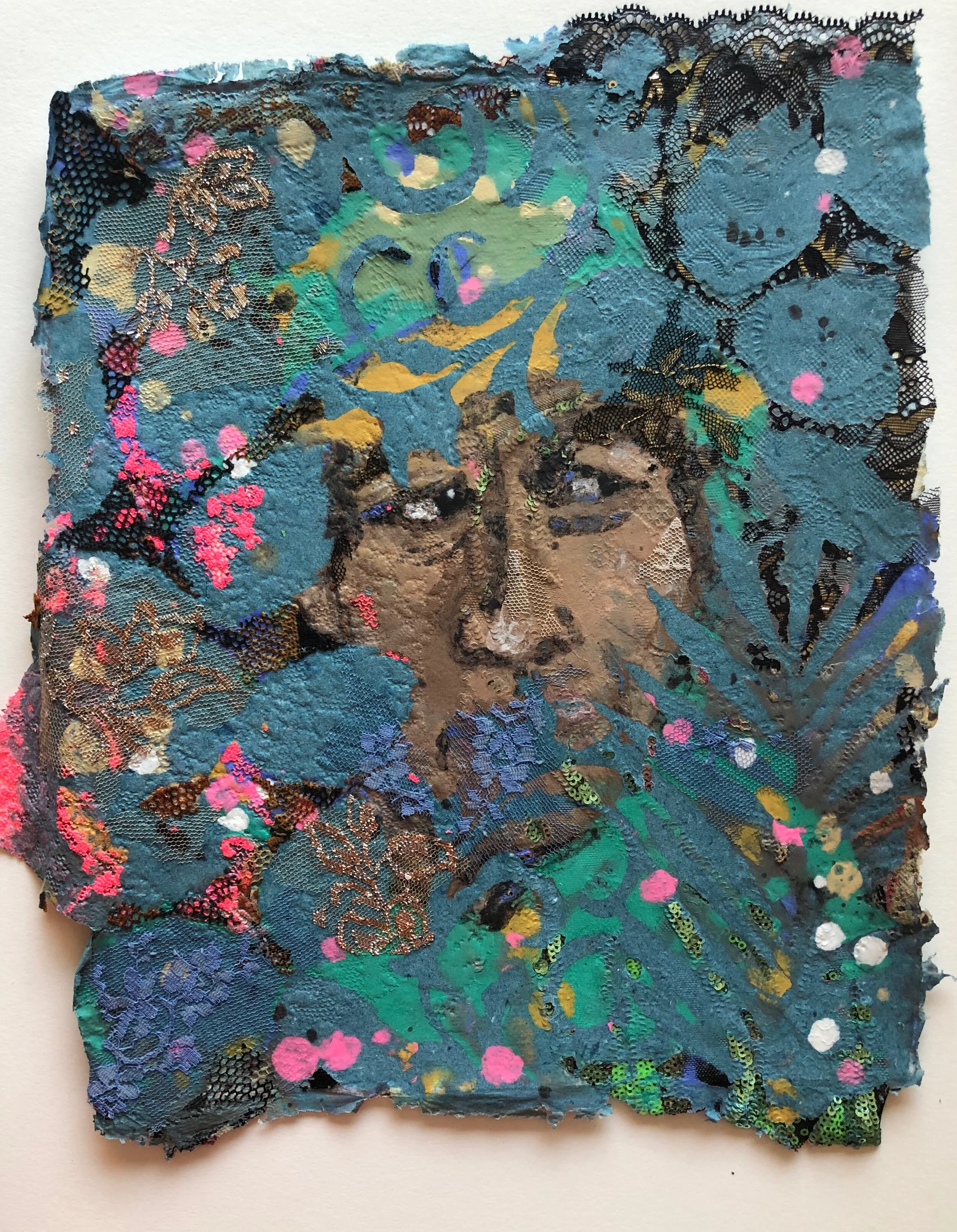Utilizing a wide variety of materials, Lina Puerta examines the relationships between nature and the body. She creates textural forms and compositions that blend the human-made world with the natural, exploring notions of control, consumerism and life's fragility. Her artistic process is in great part guided by the physical qualities of the materials, their textures, forms and colors; and informed by concepts of femininity, fashion, sexuality and artificiality.
In 2021, Puerta has upcoming solo exhibitions at the Sugarhill Children’s Museum of Art and Storytelling; Hunter College East Harlem Gallery organized with KODA, NYC; and at El Taller Puertorriqueño en Philadelphia.
Puerta has exhibited internationally and has been honored with the 2017-NYFA Fellowship in Crafts/Sculpture, 2016 Dieu Donné Workspace Residency, Artprize-8 Sustainability Award, 2015 Joan Mitchell Painters and Sculptors Grant and the 2015 Kohler Arts Industry Residency (WI) among others. She was born in New Jersey, raised in Colombia, and lives and works in New York City, and holds an MSEd in Art Education from Queens College/CUNY.
For more information, please see: LinaPuerta.net and on Instagram @linapuertaart.
Lina Puerta, Moth(er), 2020. 7’ x 6’. Quilt made with digitally printed fabric (created during 2017 Joan Mitchell Foundation Artist Residency, of food wrappings from food consumed by fellow resident artists); discarded food nets, recycled fabrics; hand-woven, indigenous Guambiano (Colombian) belt; Peruvian textile and t-shirt previously worn by artist; fake fur, sequined and textured fabrics; shells from necklaces, previously worn by the artist, purchased or gifted while in Colombia and the Caribbean; crocheted flower made by artist’s late mother, repurposed buttons and googly eyes. Photo credit: Etienne Frossard.
Lina Puerta, Moth(er) (detail), 2020. 7’ x 6’. Quilt made with digitally printed fabric (created during 2017 Joan Mitchell Foundation Artist Residency, of food wrappings from food consumed by fellow resident artists); discarded food nets, recycled fabrics; hand-woven, indigenous Guambiano (Colombian) belt; Peruvian textile and t-shirt previously worn by artist; fake fur, sequined and textured fabrics; shells from necklaces, previously worn by the artist, purchased or gifted while in Colombia and the Caribbean; crocheted flower made by artist’s late mother, repurposed buttons and googly eyes. Photo credit: Etienne Frossard.
Lina Puerta, Moth(er) (detail), 2020. 7’ x 6’. Quilt made with digitally printed fabric (created during 2017 Joan Mitchell Foundation Artist Residency, of food wrappings from food consumed by fellow resident artists); discarded food nets, recycled fabrics; hand-woven, indigenous Guambiano (Colombian) belt; Peruvian textile and t-shirt previously worn by artist; fake fur, sequined and textured fabrics; shells from necklaces, previously worn by the artist, purchased or gifted while in Colombia and the Caribbean; crocheted flower made by artist’s late mother, repurposed buttons and googly eyes. Photo credit: Etienne Frossard.
First, and most importantly, how are you doing? How are you navigating the highs and lows?
I’ve been fortunately well and healthy. At almost a year since the pandemic started, I feel that by now, we have more or less learned to live with the pandemic, reaching some new level of normalcy, which seems likely to continue for many more months to come. Art is what keeps me sane and grounded, as well as my partner’s company, the phone calls and zoom sessions with family, friends, artists and art community.
Lina Puerta, Cabbages and Radishes Parade Tapestry (from the Willard Crop’s Festival Series), 2019. 42" x 64" Overall. (8) panels of 21” x 16”. Handmade paper composed of pigmented cotton and linen pulp; embedded withlace, sequined and metallic fabrics; parts of previously worn and used embroidered Mayan huipil and Kuna cloths; discarded food packaging netting, ribbon, gouache, antique and commercial appliqués. Photo credit: Etienne Frossard.
Lina Puerta, Cabbages and Radishes Parade Tapestry (from the Willard Crop’s Festival Series) (detail), 2019. 42" x 64" Overall. (8) panels of 21” x 16”. Handmade paper composed of pigmented cotton and linen pulp; embedded withlace, sequined and metallic fabrics; parts of previously worn and used embroidered Mayan huipil and Kuna cloths; discarded food packaging netting, ribbon, gouache, antique and commercial appliqués. Photo credit: Etienne Frossard.
It's my experience that most artists engage with some level of self-isolation in their day to day art practice. Has this been your experience? And if so, have you found these innate rhythms to be helpful during this larger, world-wide experience of isolation?
Yes, indeed. The introvert part of me loves the isolation time. Being home, and in my studio, with no interruptions is like being in heaven. However, the devastating news related to the pandemic: the deaths, lack of PPE and poor response from the government, plus, the inequalities and systemic racism that have become clearer during this pandemic, has made it very difficult, at times, to concentrate on any artmaking. Having said that, the process of making art has also been a lifesaver, in the sense that it’s been therapeutic and helpful in finding focus and peace. I find that when I feel most anxious about the news and state of the world, I remind myself that the best way for me to contribute to creating positive change is by doing what I do best: making art. I feel a sense of duty to make art now, in these troubling times, more than ever.
Lina Puerta, El Saparro (Canasto)/The Basket, 2021. 35” H. x 27.5” W. Digitally printed organza silk (created during 2017 Joan Mitchell Foundation Artist Residency, of a discarded food net from food consumed by fellow resident artists), cotton and vintage fabrics; sequin, velvet, satin and lace ribbons; trim, thread, beads, fake and freshwater pearl beads; discarded food nets; seeds and shells from necklaces, previously worn by the artist, purchased or gifted while visiting Colombia and the Caribbean. Image courtesy of the artist.
Lina Puerta, El Saparro (Canasto)/The Basket (detail), 2021. 35” H. x 27.5” W. Digitally printed organza silk (created during 2017 Joan Mitchell Foundation Artist Residency, of a discarded food net from food consumed by fellow resident artists), cotton and vintage fabrics; sequin, velvet, satin and lace ribbons; trim, thread, beads, fake and freshwater pearl beads; discarded food nets; seeds and shells from necklaces, previously worn by the artist, purchased or gifted while visiting Colombia and the Caribbean. Image courtesy of the artist.
Lina Puerta, El Saparro (Canasto)/The Basket (detail), 2021. 35” H. x 27.5” W. Digitally printed organza silk (created during 2017 Joan Mitchell Foundation Artist Residency, of a discarded food net from food consumed by fellow resident artists), cotton and vintage fabrics; sequin, velvet, satin and lace ribbons; trim, thread, beads, fake and freshwater pearl beads; discarded food nets; seeds and shells from necklaces, previously worn by the artist, purchased or gifted while visiting Colombia and the Caribbean. Image courtesy of the artist.
It would be great if you could briefly talk us through your practice. Understanding it is integral to appreciating the multivalence of your work.
I create mixed media sculptures, installations, collage, handmade-paper paintings and wall hangings by combining a wide range of materials, from artificial plants, concrete and paper pulp to found, personal and recycled objects. Experimentation and intuition are a key part of my practice. My artistic process is in great part guided by the physical (and non-physical) qualities of materials, such as their colors, textures, forms, energy, history and how they react to each other, either when juxtaposed, embedded or layered. My work examines the relationship between nature and the human made and is informed by fashion, femininity, sexuality, urban decay, food justice, indigenous, and ancestral knowledge.
Lina Puerta, La Huerta y Yo (from the Kinship Series), 2020. (16) 14” x11” panels. Overall: 57” x 44”. Handmade paper composed of cotton and linen pulp, embedded with lace, velvet, sequined fabrics and discarded food nettings; finished with sequin and velvet ribbon; gouache, googly eyes and appliqué birds (handmade paper, fake fur, leather scraps, feathers, sequined, metallic and textured fabric, velvet, lace and gouache). Photo credit: Etienne Frossard.
Lina Puerta, La Huerta y Yo (from the Kinship Series) (detail), 2020. (16) 14” x11” panels. Overall: 57” x 44”. Handmade paper composed of cotton and linen pulp, embedded with lace, velvet, sequined fabrics and discarded food nettings; finished with sequin and velvet ribbon; gouache, googly eyes and appliqué birds (handmade paper, fake fur, leather scraps, feathers, sequined, metallic and textured fabric, velvet, lace and gouache). Photo credit: Etienne Frossard.
Has any of your imagery shifted in a reflection to what's currently happening? And why, or why not?
I don’t know if my imagery has shifted, but perhaps become more relevant, as the current global crisis has allowed us to see more clearly the failures and inequalities of our western system. For instance, the issues related to Latinx Farmworkers in the US, which I highlight in my Latino Farmworker Tapestries Series, have become more visible with the pandemic, as such workers are now deemed ‘essential’, yet have not been given the financial, legal and safety support they need and deserve.
Similarly, my recent work centered around the indigenous relationship with the natural, living world, teaches us alternative ways of living that will not only improve our livelihood, but will ensure a sustainable future for generations to come. Such millenary teachings are, in my opinion, of great urgency now, as the pandemic has given us an opportunity to pause and think more deeply of the broken world we are part of, but still have the ability to change.
“Improper exposure to pesticides harms 10 to 20 thousand agricultural workers every year…the people who harvest America’s food.” Source: WGCU, PBS and NPR for Southwest Florida.
Lina Puerta, Broccoli Crop Workers (from the Latino Farm Worker Series), 2017. 45” x 44”. Cotton and linen pulp; lace, velvet, sequined fabrics, Aztec (Otomi) embroidered collar, trims, appliqués, velvet ribbon, fake fur, feathers, gouache and chains. Photo credit: Jeanette May.
Lina Puerta, Broccoli Crop Workers (from the Latino Farm Worker Series) (detail), 2017. 45” x 44”. Cotton and linen pulp; lace, velvet, sequined fabrics, Aztec (Otomi) embroidered collar, trims, appliqués, velvet ribbon, fake fur, feathers, gouache and chains. Photo credit: Jeanette May.
Are you thinking differently? Coping differently? Inspired differently?
I am certainly inspired differently. The unprecedented and difficult times we have experienced as a country and global community, within the last year, have revealed very clearly the fact that a change in our system and Western ways of thinking and relating to the natural world are not working, and must change. For instance, we think of nature as if it was separate from us, something we spend time with when going to the park or outside the city. But indigenous teachings remind us that we ARE nature and therefore, we are part of an ecosystem in which we play an important role within the natural world. If we learn to pay attention and develop a sense of deep respect and reciprocity with the living world around us, I believe, we can create significant changes that would bring healing to ourselves and the earth.
Lina Puerta,Tomatoes and I (Black) (from the Kinship Series), 2020. 14” x 11”. Handmade paper composed of cotton, abaca and linen pulp, embedded with velvet, artificial leaves and discarded food nettings; sequin and velvet ribbons; gouache and googly eyes. Image courtesy of the artist.
Lina Puerta, Strawberry Leaves and I (Blue) (from the Kinship Series), 2020. 14 3/4” x 11 3/4”. Handmade paper composed of cotton and linen pulp, embedded with sequined fabric, lace and discarded food netting; sequined ribbon, trim, gouache and googly eyes. Image courtesy of the artist.
Lina Puerta,Tomatoes and I (Yellow) (from the Kinship Series), 2020. 14 3/4” x 12”. Handmade paper composed of cotton, abaca and linen pulp, embedded with sequined fabric and discarded food netting; finished with sequin and velvet ribbon; gouache and googly eyes. Image courtesy of the artist.
Lina Puerta, Tomatoes and I (Yellow) (from the Kinship Series) (detail), 2020. 14 3/4” x 12”. Handmade paper composed of cotton, abaca and linen pulp, embedded with sequined fabric and discarded food netting; finished with sequin and velvet ribbon; gouache and googly eyes. Image courtesy of the artist.
What is bringing you solace, or even joy, in this moment?
Simple things like cooking, going on walks, talking with friends and family, and artmaking are bringing me joy. During this pandemic I’ve been meeting regularly over zoom with two wonderful groups of Latinx women, most of whom are artists. These meetings have been incredibly nurturing and uplifting! Also, in the first months of the pandemic, it felt nice to slow down and free up a bit from deadlines and the pressures of being constantly productive.
“In a 2012 report, Human Rights Watch surveyed female farmworkers; nearly all of them had experienced sexual violence, or knew others who had.” Source: Human Rights Watch.
Lina Puerta, Tomato Crop Picker (from the Latino Farm Worker Series), 2017. 56” x 35”. Cotton and linen pulp; lace, velvet ribbon, sequined and metallic fabrics; trims, beaded and embroidered appliqués; fake fur, feathers, gouache and chains. Photo credit: Jeanette May.
“Workers earn between 65 and 80 cents for each large [20lb] bucket of chile they pick. The fastest pick 100 buckets a day.” Source: sfreporter.com.
Lina Puerta, Chili Pepper Crop Picker (from the Latino Farm Worker Series), 2017. 58” x 33”. Cotton and linen pulp; lace, velvet ribbon, sequined fabrics, trims, beaded and embroidered appliqués; fake fur, feathers, gouache and chains. Photo credit: Jeanette May.
“Strawberries, nicknamedla fruta del diablo (the devil's fruit) because pickers have to bend over all day.” Source: The Economist.
Lina Puerta, Strawberry Crop Picker (from the Latino Farm Worker Series), 2017. 52” x 47”. Cotton and linen pulp; lace, velvet, sequined fabrics, handmade woven textile, trims, appliqués, velvet ribbon, fake fur, feathers, pom-poms and gouache. Photo credit: Jeanette May.
Lina Puerta, Strawberry Crop Picker (from the Latino Farm Worker Series) (detail), 2017. 52” x 47”. Cotton and linen pulp; lace, velvet, sequined fabrics, handmade woven textile, trims, appliqués, velvet ribbon, fake fur, feathers, pom-poms and gouache. Photo credit: Jeanette May.
What research or writing are you doing that you find compelling?
Right now, I’m very much into learning about indigenous knowledge from the Americas, but especially of Latin America. I’m reading various writings and listening to lectures by Silvia Rivera Cusicanqui. She’s a Bolivian feminist, activist, and sociologist who presents a fresh perspective on decolonization and indigenous ways of thinking.
Lina Puerta, Untitled (Blue) (from the Latino Farmworkers in the US - Portraits Series), 2018. 16” x 13”. Pigmented cotton and linen pulp; sequined fabrics and lace. Image courtesy of the artist.
Lina Puerta, Untitled (Turquoise) (from the Latino Farmworkers in the US - Portraits Series), 2018. 16” x 14”. Pigmented cotton and linen pulp; sequined fabric and lace. Image courtesy of the artist.
Are you reading anything?
I’m re-reading Braiding Sweetgrass by Robin Wall Kimmerer, which is also a compelling book on indigenous relationship to nature.




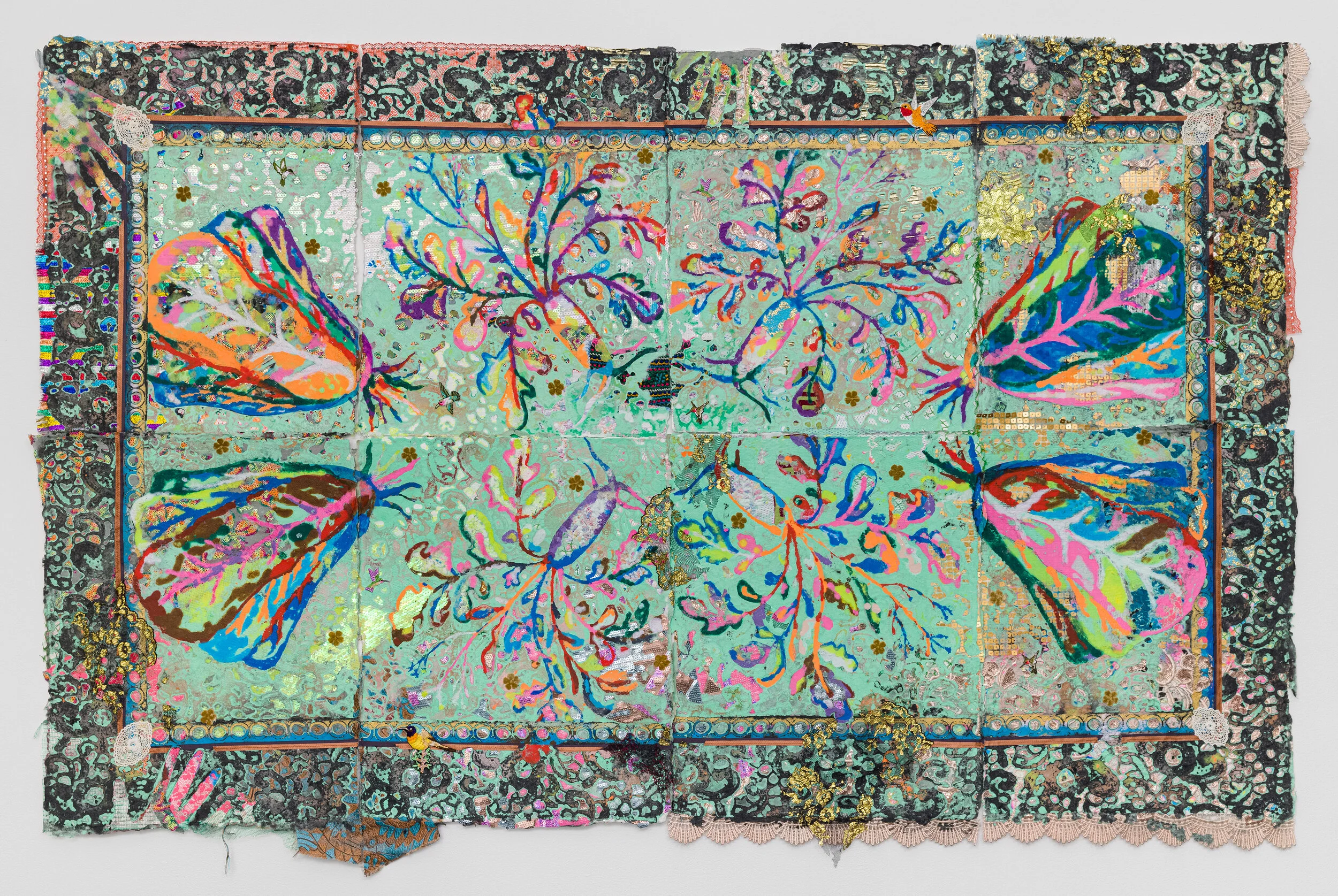


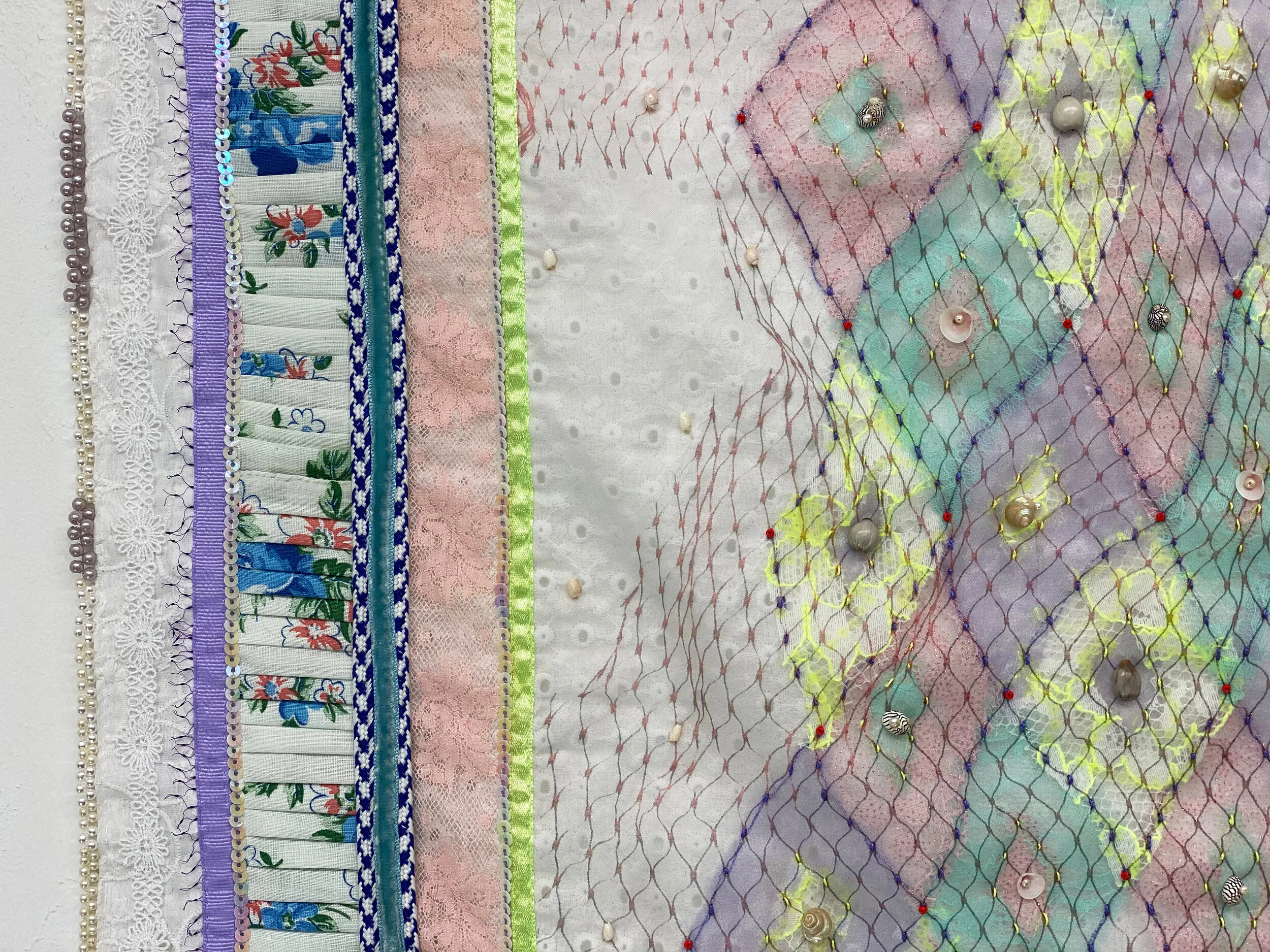



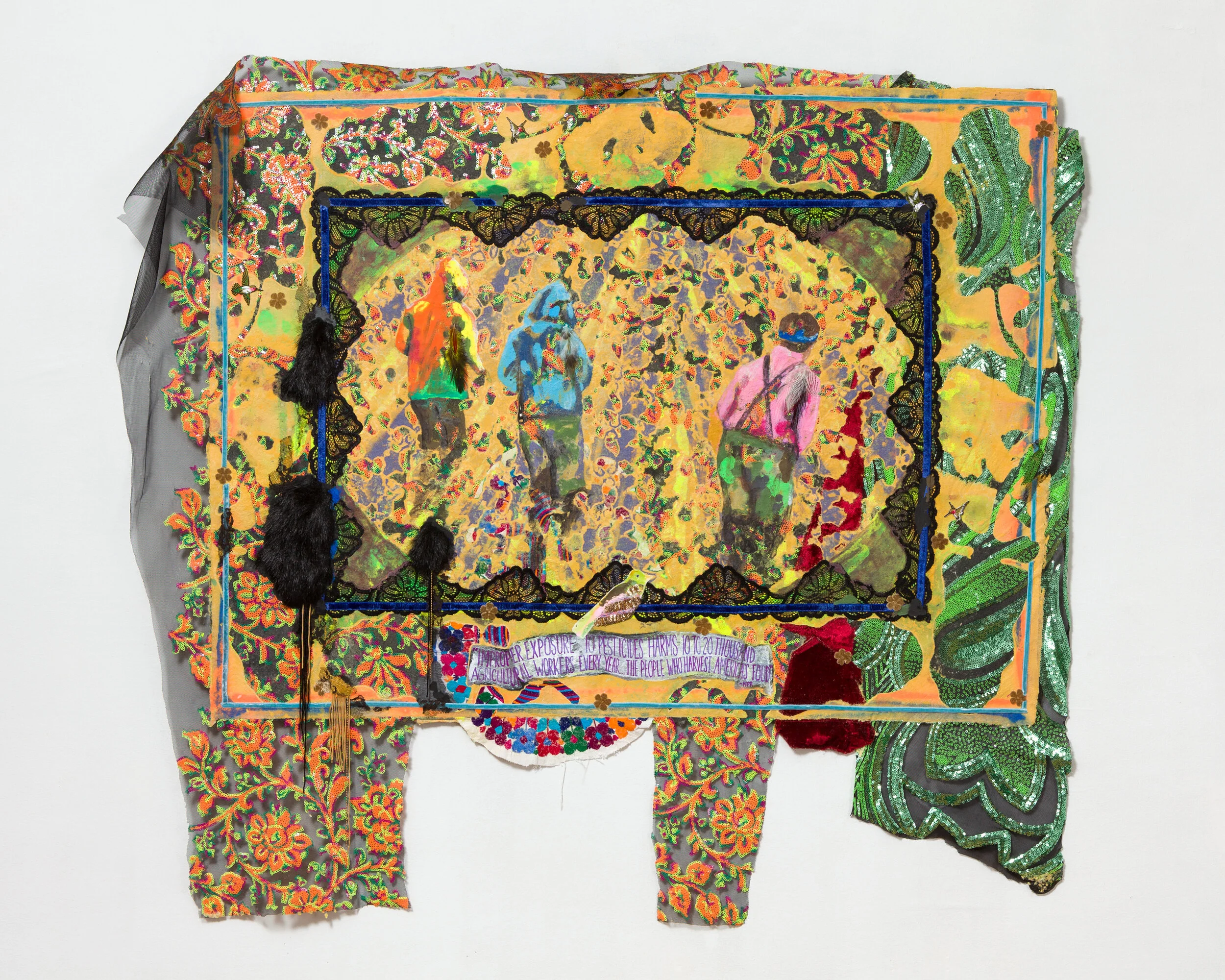



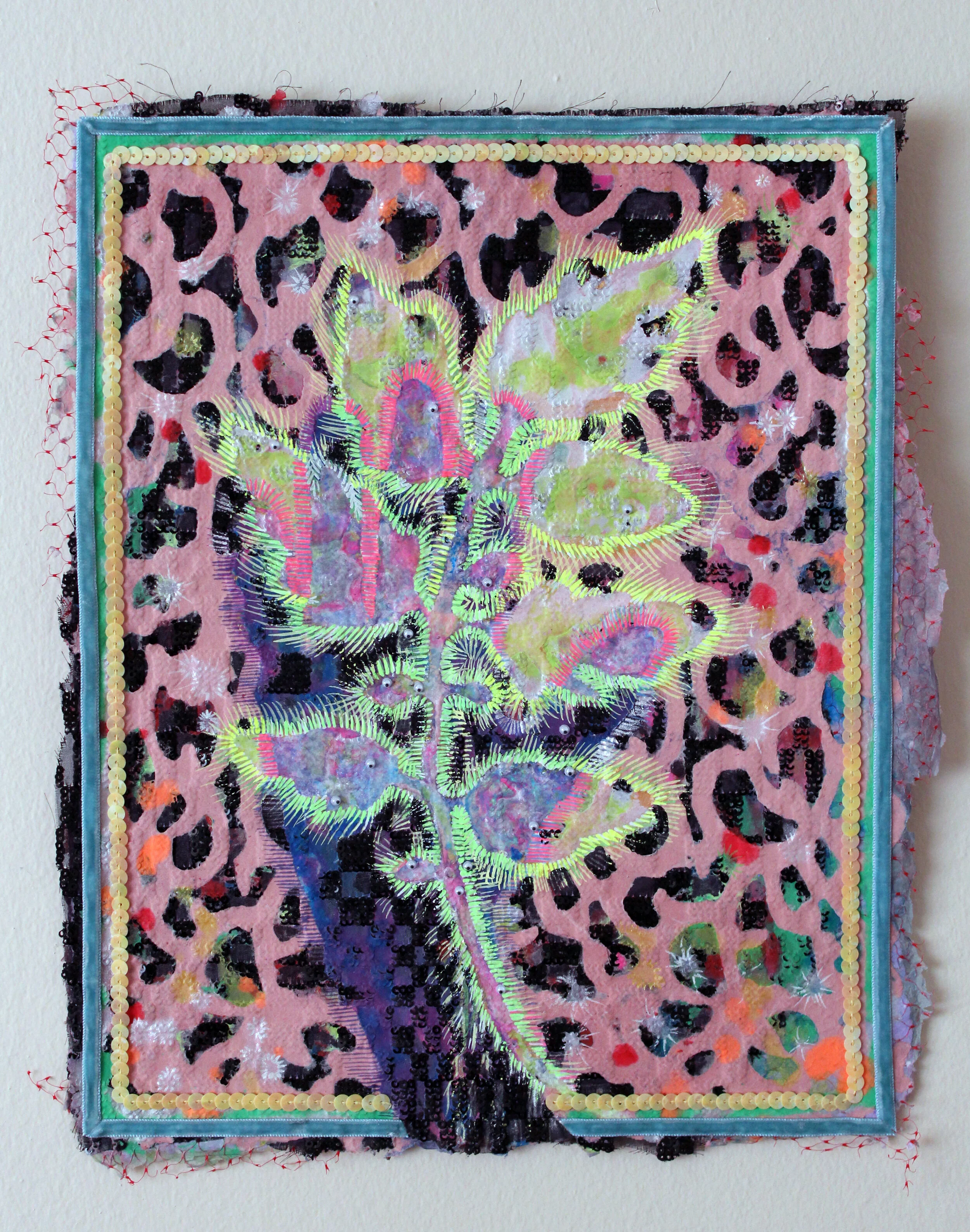

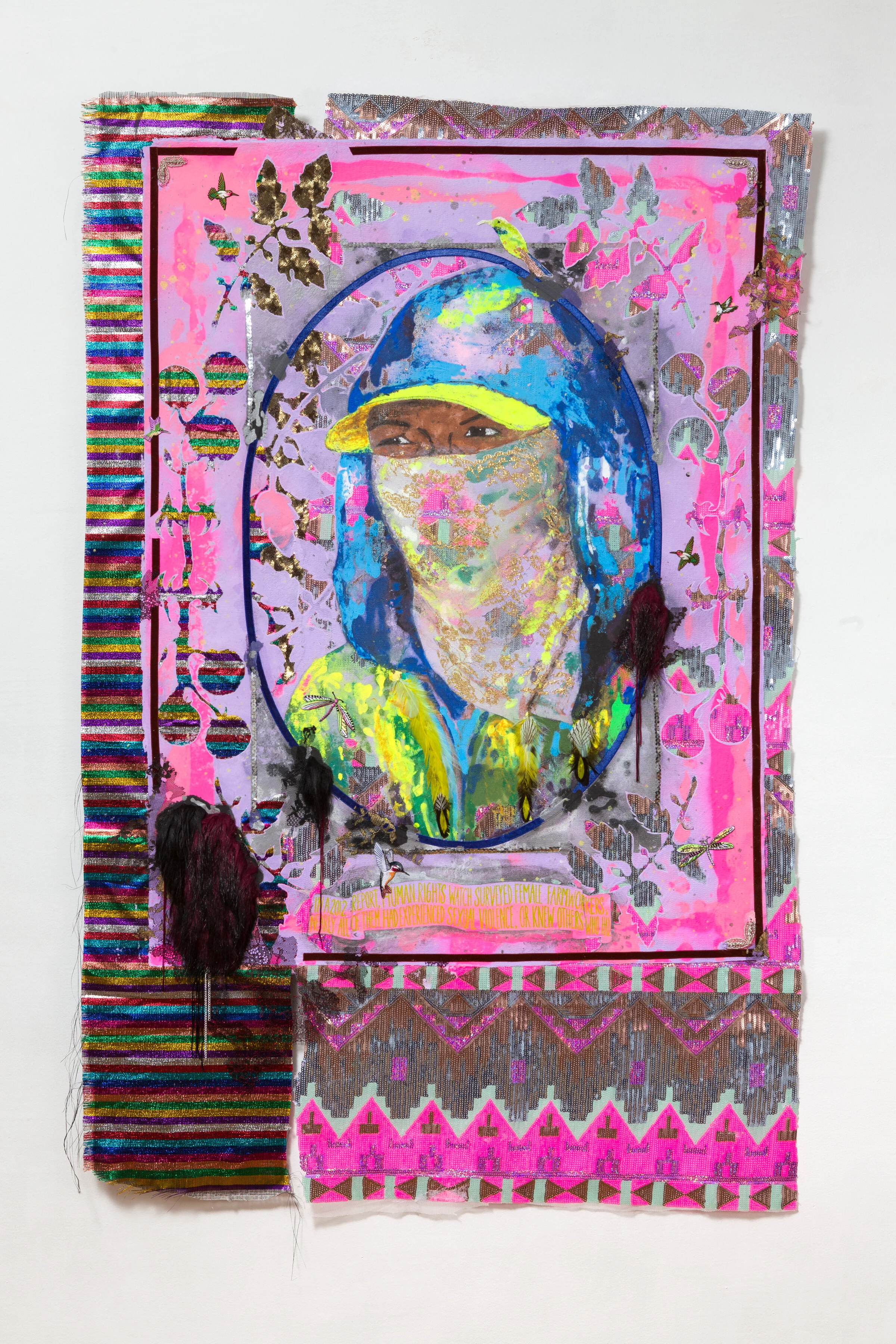
![“Workers earn between 65 and 80 cents for each large [20lb] bucket of chile they pick. The fastest pick 100 buckets a day.” Source: sfreporter.com.Lina Puerta, Chili Pepper Crop Picker (from the Latino Farm Worker Series), 2017. 58” x 33”…](https://images.squarespace-cdn.com/content/v1/52d65ee2e4b07924afb0cef3/1615043682200-3FVJZHT301JDYABOM8KB/18_Chili+pepper+crop+worker.jpg)



